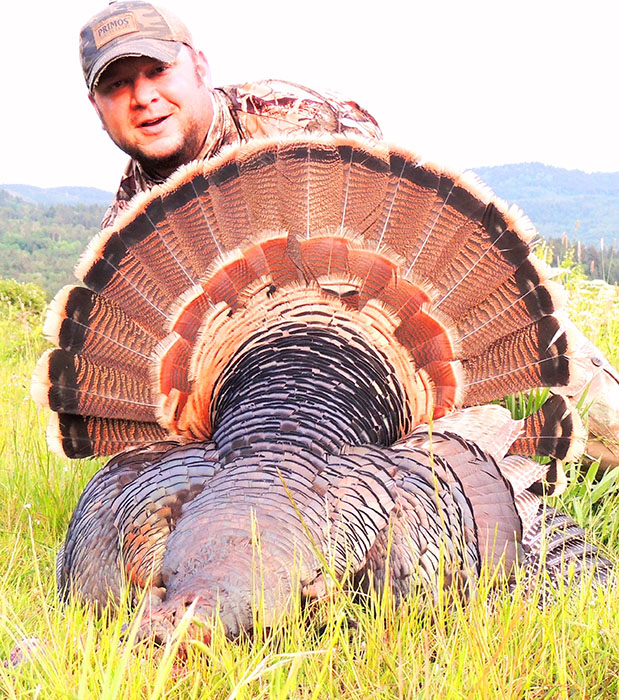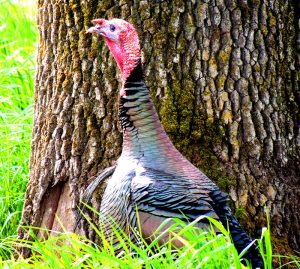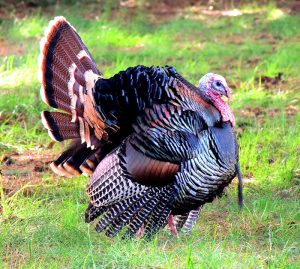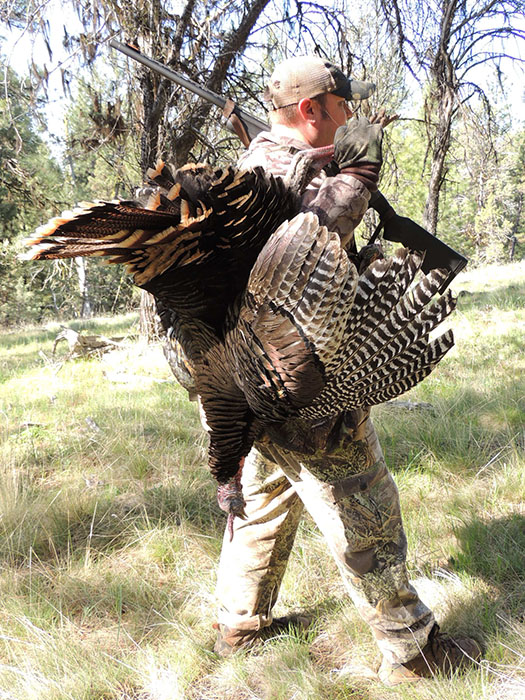Tips for Bagging a Late Season Turkey Leave a reply

The author took this mid May bird last season while waiting near a well traveled trail after patterning the old gobbler. (Troy Rodakowski)
by Troy Rodakowski
Adult turkeys are in many ways like a husband and wife. For example, if you are asked to do something over and over (nagged) by either your husband or wife you will shut down and do it when you feel like doing it rather than when you are asked. Likewise, gobblers will shut down after hearing those repetitious yelps and cackles that they have heard for nearly a month.
During the late season birds tend to be more receptive to light purring and soft clucking. I have always preferred a mouth diaphragm for this type of calling because I can control the amount of air forced over the reeds to produce nice authentic sounds while keeping my hands free. Of course, other calls like slate, box, and wing-bone calls can also work well if you are experienced with them.

Old wise gobblers will seek out secluded locations to strut and spend the warm late spring days. (Troy Rodakowski)
The combination of light calling and patience will pay dividends though and that’s definitely my preferred tactic for late season turkey hunting. It isn’t uncommon for these birds to come in unannounced during the late season so keep your head on a swivel. And even though I prefer softer calling I’ll sometimes throw some soft yelps out there from time to time also. Of course, every situation is different and will present different challenges.
To be successful on any turkey hunt it’s critical to choose an area that you’ve scouted or have frequently seen turkeys visit. Patterning these birds is probably the most important step to harvesting one of them. Dusting and strutting areas are good places to start and finding travel routes from a roosting area to a strut zone is a great advantage also. Just when you think you have them figured out though some birds will find different routes from day to day en route to their strutting and dusting sites.
I had a fellow turkey hunter once tell me a story about a bird that would fly to his strut area every day from his roost site. Upon arrival, he would use a different entry point every single time. Needless to say, that bird survived the spring season without any problems. Yes, turkeys learn and are very smart.

The birds you pursue late in the season are educated and very wise. They learn from experience how to survive. (Troy Rodakowski)
Creek bottoms and other drainages provide great areas for insects and fresh forage during the late season. Many times, old solitary gobblers will wander around these areas looking for a receptive hen while feeding. So, make sure to search these areas thoroughly for sign. Looking in the dirt along small game trails and old cat roads for fresh tracks and scat is a sure sign that there are birds in the area.
When I’m trying to locate birds in the evening I’ll use an owl hoot or crow call as a locator call and during the mid-morning and afternoon I’ll use a coyote call to inspire a gobble. Once you locate a bird remember that patience is very important to entice these sometimes uneasier birds to come in. I have taken several birds while only hearing a single gobble and then waiting them out for what seems like an eternity.
Under most late season scenarios waiting only 30-45 minutes at a set-up is not enough. I don’t know how many times I have been ready to call it quits when that bird finally shows up. Learning from experience, I know that I have prematurely left areas and ruined opportunities to harvest at least a few birds.
If you can somehow get onto private land later in the season you’ll usually find birds that are more settled and receptive. The best bet is to find an area with a lower concentration of people to locate settled birds that have moved away from the pressure and that often means getting access to private land.

Coming out of the woods with a May turkey is very satisfying and quite an accomplishment. (Gary Lewis)
I can’t emphasize patience enough. Remembering what these birds have been through for a month prior will keep you in the right mindset. Once eager to find love at the start of the season these turkeys have become more reclusive and are often loners during their continued searches for a hen. Nagged by multiple hunters over the previous weeks and hearing every sound imaginable has only made them more wary. Seeing decoys made of plastic and paint, hunters moving through the woods, and the occasional resonating sound of a shotgun has made them that much more shy and edgy.
Even though it’s a little more difficult to harvest a bird later in the season it’s never too late to bag your bird and I have taken turkeys throughout the season and on several occasions on the last day. Yes, it’s warm and seems as if the turkey rut has passed, but often times the final month provides some of the best hunting.
Tall grassy pastures being grown for hay and meadows or fields near adjacent wood lots will hold good numbers of turkeys. However, turkeys will avoid them in the morning hours when the dew is heavy on the grass. Gobblers will hesitate to cross grassy fields that have heavy dew and will work the perimeters of the grassy areas in search of hens especially early in the mornings.
Late in the day after the field or pasture has dried from the warm wind turkeys will be easier to coax across to your location. Frequently birds will venture into locations where tall grasses and other forages have grown during the warm spring weather. These areas will hold a variety of insects such as caterpillars, flies, beetles, slugs, snails and many other insects and invertebrates that turkeys can’t resist. Birds typically won’t venture too far from the security of the woods, the tall grass, and the lunch box.
A turkeys mind and actions tend to slowly evolve during the season. Many times just when you are about to throw in the towel and head for home I can’t tell you how important it is to stay a little longer. Take a sandwich, some water and snacks in your pack, and spend the day and perhaps all the way into the early evening. Be polite, gentle, and patient in your calling approach and you might just coax a late season bird into range. Expect to see things you’ve never seen before and definitely be willing to change some of your tactics and chances are good things will happen.
Troy Rodakowski
Outdoor Line Blogger
710 ESPN Seattle

